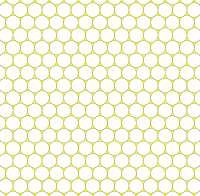Triangular tiling
| Triangular tiling | |
|---|---|
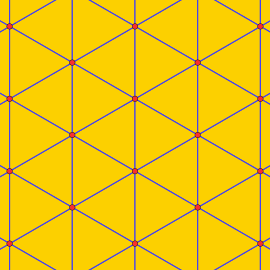 | |
| Type | Regular tiling
|
| Vertex configuration | 3.3.3.3.3.3 (or 36) |
Face configuration |
V6.6.6 (or V63) |
| Schläfli symbol(s) | {3,6} {3[3]} |
| Wythoff symbol(s) | 6 | 3 2 3 | 3 3 | 3 3 3 |
| Coxeter diagram(s) | |
| Symmetry | p6m , [6,3], (*632)
|
| Rotation symmetry | p6, [6,3]+, (632) , [3[3]]+, (333)
p3 |
| Dual | Hexagonal tiling |
| Properties | face-transitive
|
In geometry, the triangular tiling or triangular tessellation is one of the three regular tilings of the Euclidean plane, and is the only such tiling where the constituent shapes are not parallelogons. Because the internal angle of the equilateral triangle is 60 degrees, six triangles at a point occupy a full 360 degrees. The triangular tiling has Schläfli symbol of {3,6}.
English mathematician
It is one of three regular tilings of the plane. The other two are the square tiling and the hexagonal tiling.
Uniform colorings
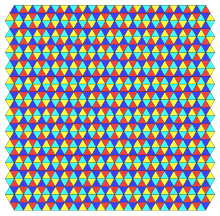
There are 9 distinct uniform colorings of a triangular tiling. (Naming the colors by indices on the 6 triangles around a vertex: 111111, 111112, 111212, 111213, 111222, 112122, 121212, 121213, 121314) Three of them can be derived from others by repeating colors: 111212 and 111112 from 121213 by combining 1 and 3, while 111213 is reduced from 121314.[1]
There is one class of
| 111111 | 121212 | 111222 | 112122 | 111112(*) |

|

|

|

|

|
| p6m (*632) | p3m1 (*333) | cmm (2*22) | p2 (2222) | p2 (2222) |
| 121213 | 111212 | 111112 | 121314 | 111213 |

|

|

|

|

|
| p31m (3*3) | p3 (333) | |||
A2 lattice and circle packings

2 lattice as three triangular tilings:


 +
+ 

 +
+ 


The
The A*
2 lattice (also called A3
2) can be constructed by the union of all three A2 lattices, and equivalent to the A2 lattice.


 +
+ 

 +
+ 

 = dual of
= dual of 

 =
= 


The vertices of the triangular tiling are the centers of the densest possible circle packing.[3] Every circle is in contact with 6 other circles in the packing (kissing number). The packing density is π⁄√12 or 90.69%. The
Geometric variations
Triangular tilings can be made with the equivalent {3,6} topology as the regular tiling (6 triangles around every vertex). With identical faces (
-
Scalene triangle
p2 symmetry -
Scalene triangle
pmg symmetry -
Isosceles triangle
cmm symmetry -
Right triangle
cmm symmetry -
Equilateral triangle
p6m symmetry
Related polyhedra and tilings
The planar tilings are related to
This tiling is topologically related as a part of sequence of regular polyhedra with Schläfli symbols {3,n}, continuing into the hyperbolic plane.
| *n32 symmetry mutation of regular tilings: {3,n} | |||||||||||
|---|---|---|---|---|---|---|---|---|---|---|---|
| Spherical | Euclid. | Compact hyper. | Paraco. | Noncompact hyperbolic | |||||||

|

|

|

|

|

|

|

|

|

|

|

|
| 3.3 | 33 | 34 | 35 | 36 | 37 | 38 | 3∞ | 312i | 39i | 36i | 33i |
It is also topologically related as a part of sequence of
 V3.6.6 |
 V4.6.6 |
 V5.6.6 |
 V6.6.6 |
V7.6.6
|
Wythoff constructions from hexagonal and triangular tilings
Like the uniform polyhedra there are eight uniform tilings that can be based from the regular hexagonal tiling (or the dual triangular tiling).
Drawing the tiles colored as red on the original faces, yellow at the original vertices, and blue along the original edges, there are 8 forms, 7 which are topologically distinct. (The truncated triangular tiling is topologically identical to the hexagonal tiling.)
| Uniform hexagonal/triangular tilings | ||||||||
|---|---|---|---|---|---|---|---|---|
| Fundamental domains |
Symmetry: [6,3], (*632) | [6,3]+, (632) | ||||||
| {6,3} | t{6,3} | r{6,3} | t{3,6} | {3,6} | rr{6,3} | tr{6,3} | sr{6,3} | |

|

|

|

|

|

|

|

|

|
| Config. | 63 | 3.12.12 | (6.3)2 | 6.6.6 | 36 | 3.4.6.4 | 4.6.12 | 3.3.3.3.6 |
| Triangular symmetry tilings | |||||||||||
|---|---|---|---|---|---|---|---|---|---|---|---|
| Wythoff | 3 | 3 3 | 3 3 | 3 | 3 | 3 3 | 3 3 | 3 | 3 | 3 3 | 3 3 | 3 | 3 3 3 | | | 3 3 3 | |||
| Coxeter | |||||||||||
| Image Vertex figure |
 (3.3)3 |
 3.6.3.6 |
 (3.3)3 |
 3.6.3.6 |
 (3.3)3 |
 3.6.3.6 |
 6.6.6 |
3.3.3.3.3.3 | |||
Related regular complex apeirogons
There are 4
The first is made of 2-edges, and next two are triangular edges, and the last has overlapping hexagonal edges.

|
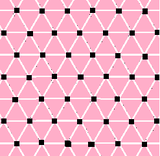
|
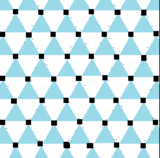
|
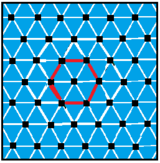
|
| 2{6}6 or |
3{4}6 or |
3{6}3 or |
6{3}6 or |
|---|
Other triangular tilings
There are also three
Kisrhombille 30°-60°-90° right triangles |
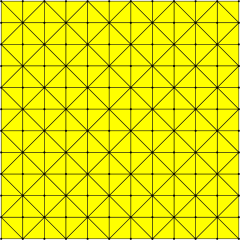 Kisquadrille 45°-45°-90° right triangles |
Kisdeltile 30°-30°-120° isosceles triangles |
See also
- Triangular tiling honeycomb
- Simplectic honeycomb
- Tilings of regular polygons
- List of uniform tilings
- Isogrid (structural design using triangular tiling)
References
- ^ Tilings and patterns, p.102-107
- ^ "The Lattice A2".
- ^ Order in Space: A design source book, Keith Critchlow, p.74-75, pattern 1
- ^ Tilings and Patterns, from list of 107 isohedral tilings, p.473-481
- ^ Coxeter, Regular Complex Polytopes, pp. 111-112, p. 136.
- ISBN 0-486-61480-8p. 296, Table II: Regular honeycombs
- ISBN 0-7167-1193-1. (Chapter 2.1: Regular and uniform tilings, p. 58-65, Chapter 2.9 Archimedean and Uniform colorings pp. 102–107)
- ISBN 0-486-23729-X. p35
- John H. Conway, Heidi Burgiel, Chaim Goodman-Strauss, The Symmetries of Things 2008, ISBN 978-1-56881-220-5 [1]
External links
- Weisstein, Eric W. "Triangular Grid". MathWorld.
- Klitzing, Richard. "2D Euclidean tilings x3o6o - trat - O2".
| Space | Family | / / | ||||
|---|---|---|---|---|---|---|
| E2 | Uniform tiling | {3[3]} | δ3 | hδ3 | qδ3 | Hexagonal |
| E3 | Uniform convex honeycomb
|
{3[4]} | δ4 | hδ4 | qδ4 | |
| E4 | Uniform 4-honeycomb
|
{3[5]} | δ5 | hδ5 | qδ5 | 24-cell honeycomb |
| E5 | Uniform 5-honeycomb
|
{3[6]} | δ6 | hδ6 | qδ6 | |
| E6 | Uniform 6-honeycomb
|
{3[7]} | δ7 | hδ7 | qδ7 | 222 |
| E7 | Uniform 7-honeycomb
|
{3[8]} | δ8 | hδ8 | qδ8 | 133 • 331 |
| E8 | Uniform 8-honeycomb
|
{3[9]} | δ9 | hδ9 | qδ9 | 152 • 251 • 521 |
| E9 | Uniform 9-honeycomb
|
{3[10]} | δ10 | hδ10 | qδ10 | |
| E10 | Uniform 10-honeycomb | {3[11]} | δ11 | hδ11 | qδ11 | |
| En-1 | Uniform (n-1)-honeycomb | {3[n]}
|
δn | hδn | qδn | 1k2 • 2k1 • k21 |

